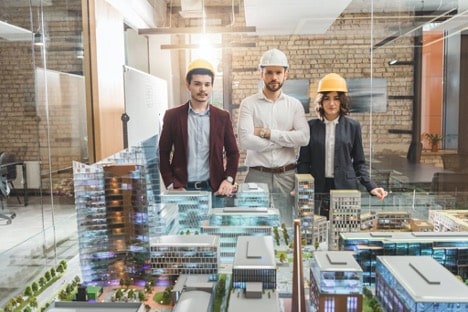The COVID-19 pandemic sparked significant shifts in the design and construction of modern structures. There emerged a focus on safety and well-being, combined with the merging of flexible spaces and cutting-edge engineering. In the construction sector, complications, including disrupted supply lines, limited workforces, and altered protocols, are now encountered. Despite barriers, the future for post-pandemic designs seems promising, with an emphasis on health, integration with nature, and progressive building methods. A Alberto Lugo examines the pandemic’s impact on modern architecture and critical changes shaping the future of development.
Contents
The Impact of the Pandemic on Modern Building Designs
The outbreak impacted modern architectural plans, affecting urban planning and environmental design. Designers and builders have adapted their approaches to accommodate changes caused by COVID-19. A notable development in responding to the pandemic involved a focus on developing flexible spaces that can transform to satisfy varying needs. This led architects to integrate more open floorplans and movable sections, allowing for reconfiguration. Attention was also focused on improving indoor air quality through improved ventilation and incorporating greenery within structures.
How Has the Pandemic Changed the Priorities of Building Designs?
The crisis forced developers to reconsider how structures are utilized, with well-being, adaptability, and technology-enhanced security above all else. Aesthetics now share equal importance with functionality and comfort. Architects implement technologies, sophisticated airflow, and optimized floorplans to decrease transmission. Organizations require flexible work areas accommodating changing health protocols and social distancing rules. Remote monitoring and smart sensors have become fundamental to ensuring protection and efficiency.
Emphasis on Health and Safety Measures
Prioritizing health and sustainability has led architects to upgrade ventilation, opt for smart technologies, and consider materials’ environmental impacts. Developers focus on spaces improving well-being above anything else while respecting the Earth. Energy-efficient lighting, water-saving fixtures, and eco-friendly building materials are now standard, as green roofs, solar arrays, and rain harvesting benefit inhabitants and reduce carbon emissions.
Incorporation of Flexible Spaces
Adaptable environments that can be changed have increasingly become standard components of innovative architectural plans, a response to the growth of remote work and the necessity for flexible interiors. Spatial organization and arrangement emphasize flexibility to accommodate a variety of needs. This transition towards versatile spaces is apparent in the free-flowing designs that promote collaboration and versatility in workplaces. The integration of cutting-edge technology and sustainable materials further enhances the flexibility of these spaces that can adjust to fluctuating work demands and preferences.
Integration of Technology
The integration of cutting-edge technologies has revolutionized modern architectural designs, seamlessly integrating digital tools, state-of-the-art infrastructure, and improved connectivity. Developers now leverage virtual solutions to create more thoughtful and efficient interiors. These groundbreaking innovations have substantially transformed both the material features of structures and how planners cooperate with clients. Through immersive virtual models and planning software, architects can provide clients with a more in-depth grasp of initiatives before starting.
What Are the Key Changes in Building Designs?
The pandemic has caused significant changes to architectural designs, emphasizing sustainability, regenerating outdoor spaces, and incorporating amenities promoting health. Designers are reimagining areas to focus on health, environmental protection, and well-being above all else. This realignment towards comprehensive solutions is reshaping how buildings are built and managed, ensuring constructions serve purposes effectively while also making positive contributions to the surroundings and inhabitants. Spaces are now conceptualized with a focus on maximizing natural daylight and airflow, and integrating greenery and exterior sections.
Shift to Remote Work and Virtual Collaboration
Architects are reassessing structural plans to serve both virtual and remote work. To satisfy corporations embracing remote work, architects integrate flexible workstations, designated meeting spots, and technology-augmented meeting rooms into their designs. By merging traditional office blueprints with remote work-friendly elements, these architects aim to foster a sense of community within the work environment, even when physical presence is limited.
Demand for Sustainable and Resilient Designs
There is a growing demand for eco-friendly and thoughtfully planned buildings. Architects are prioritizing ecologically conscious, forward-looking solutions for long-term stability. This strategic shift towards architecture involves seamlessly integrating natural light, cross ventilation, and regenerative power sources into clever schemes.
Revival of Outdoor Spaces
The pandemic sparked fresh curiosity about spaces outside buildings. Designers visualize outdoor areas to promote wellness and connection to nature. They add lush walls, rooftop gardens overflowing with flora, and secluded corners, bringing nature indoors. Using sustainable materials and local plants, these spaces enhance aesthetics and health.
Future Predictions for Post-pandemic Building Designs
Moving ahead, architects envision resilient spaces prioritizing health and environmental responsibility.
Continued Emphasis on Health and Safety
The future will keep health, safety, and adaptability at the forefront through a proper balance. Designers prioritize inventive indoor solutions as needs vary, embracing daylight, greenery, and air, with configurations fitting various uses. Ergonomics and eco-wares ensure standards are met while benefiting individuals and groups.
Integration of Biophilic Design
Biophilic integration is anticipated to play a prominent role in developing buildings that enable connections with nature. Architects embrace these design principles to develop environments, maximizing well-being and sustainability through access to natural light, greenery, and air circulation. By integrating indoor and outdoor spaces more seamlessly, the transitions between constructed and natural settings will become more fluid.
Increased Use of Prefabrication and Modular Construction
Designers are embracing off-site assembly methods to optimize efficiency and reduce environmental impact. This transition towards modular buildings and prefabricated elements is transforming the planning and development process. By manufacturing components remotely, architects can substantially decrease construction waste and minimize disturbances at job sites.







